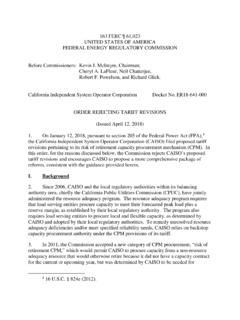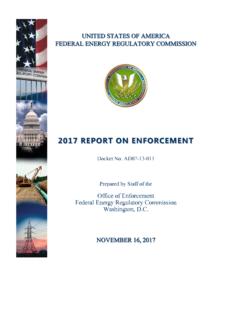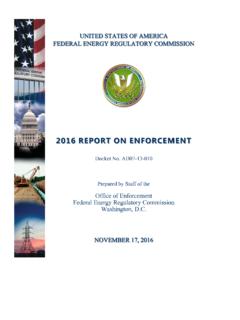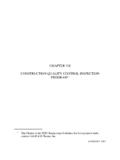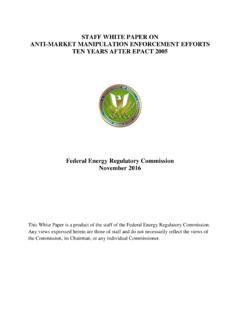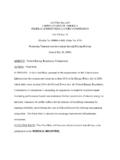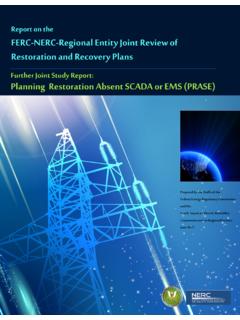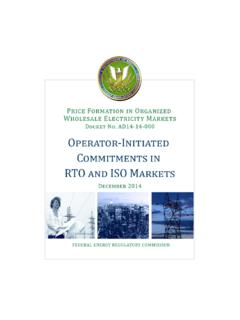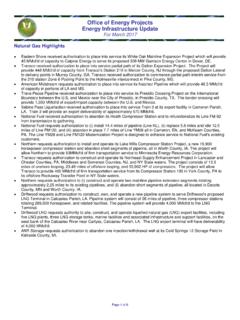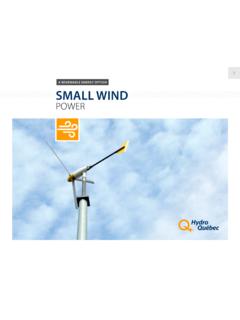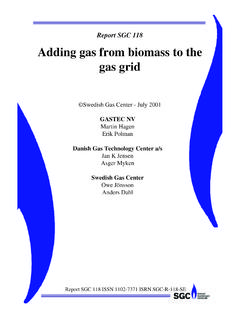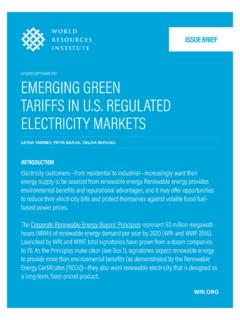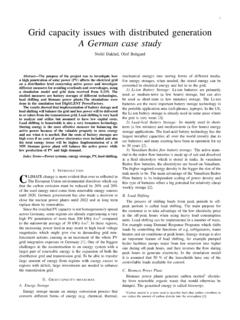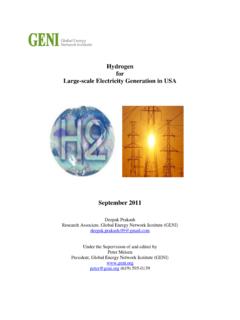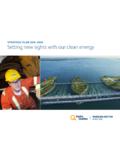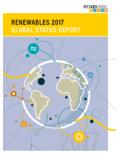Transcription of Hydropower Primer - Federal Energy Regulatory …
1 Hy d r o p o w e r pr i m e rA Handbook of Hydropower BasicsA staff report of the Office of Energy Projects/ Federal Energy Regulatory CommissionHydropower primerPURPOSE OF THIS Primer This Hydropower Primer provides an overview of the Federal Energy Regulatory commission s role in regulating and overseeing non- Federal Hydropower generation in the United States. It provides a history of Hydropower and describes the role Hydropower plays in the nation s Energy mix. The Primer explains the different types of Hydropower projects and the resources they affect. Further, it discusses the regulations and statutes applicable to the Hydropower program. The Primer describes the role of the Office of Energy Projects and its three divisions that work together to review Hydropower project applications through the various licensing processes, oversee compliance and administration, and ensure dam safety.
2 Finally, it provides an overview of how the public and agencies can interact with the commission and the outreach opportunities provided by commission staff. It is written to be used either as a traditional text read front to back or as a reference guide. Consequently, some material is repeated in different sections, and references are provided to other parts of the Primer where a concept is addressed in greater detail. Additional information about various aspects of Hydropower and FERC regulation can be found at A staff report of the Office of Energy Projects/ Federal Energy Regulatory commission Hydropower Primer iii Hydropower Primer A Handbook of Hydropower Basics February 2017 PURPOSE OF THIS Primer iii 1.
3 Hydropower IN THE UNITED STATES 1 Overview 1 Project Types and Configurations 4 Environmental Concerns 11 Developmental Issues 16 2. PERTINENT LAWS AND REGULATIONS RELATED TO NON- Federal Hydropower PROJECTS 17 Federal Power Act 17 Rivers and Harbors Act 19 Bureau of Reclamation Statutes 19 National Environmental Policy Act 20 Clean Water Act 21 Endangered Species Act 21 Fish and Wildlife Coordination Act 22 National Historic Preservation Act 22 Coastal Zone Management Act 22 Magnuson-Stevens Fishery Conservation and Management Act 23 Marine Mammal Protection Act 23 Wild and Scenic Rivers Act 23 Pacific Northwest Power Planning and Conservation Act 23 3. Federal Energy Regulatory commission 24 Overview of Agency 24 Office of Energy Projects 24 Hydropower Program 25 Hydropower Primer v 4.
4 Hydropower PERMITS AND AUTHORIZATIONS 28 Overview 28 Preliminary Permits 29 Licenses 30 Exemptions 35 Amendments 36 Surrenders, Transfers, and Terminations 38 5. Hydropower ADMINISTRATION AND COMPLIANCE 41 Overview 41 Environmental Inspections 42 Compliance Tracking and Monitoring 42 License Transition Meetings 42 Shoreline Management 43 Recreation Facilities 43 Compliance Penalties 44 Headwater Benefits 44 6. DAM SAFETY AND INSPECTIONS OF Hydropower PROJECTS 45 Overview 45 Regulations 45 Reporting Safety-Related Incidents 46 Emergency Action Plans 46 Independent Safety Inspections 48 Public Safety 49 Security 51 Engineering Guidelines 51 Owners Dam Safety Program 51 Dam Safety Performance Monitoring Program, Potential Failure Mode Analysis, and Risk-Informed Decision Making 52 Dam Safety Remediation 52 7.
5 PUBLIC RESOURCES AND OUTREACH 53 Electronic Systems 53 Outreach 54 8. GLOSSARY 55 9. LIST OF ACRONYMS AND ABBREVIATIONS 58 The Hydropower Primer is a staff product and does not necessarily reflect the views of the commission or any Commissioner. All images credit to FERC unless stated otherwise. Pictures on cover from left to right: York Haven reservoir, PA; Merwin Dam, WA; Wanapum Dam, WA. vi Hydropower Primer 1. Hy d r o p o w e r i n t H e Un i t e d St a t e S Overview Introduction Hydroelectric projects are currently in almost every state and on most of the major river systems in the United States, with a combined 101,000 megawatts (MW) of electric generating capacity. Hydroelectric generation accounts for about 8 percent of the total generating capacity in the United States and about 48 percent of all renewable generation.
6 States that have significant water resources, such as those in the Pacific Northwest, obtain a large percentage of their power from hydroelectric projects. Hydroelectric projects are owned and operated by private, non-utility companies; private utility companies; municipalities; electric cooperatives; private citizens; and state and Federal government agencies. Federal agencies that own hydroelectric projects include: the Army Corps of Engineers (Corps), Bureau of Reclamation (Reclamation), Tennessee Valley Authority (TVA), Bureau of Indian Affairs, and the International Boundary and Water commission . The Corps and Reclamation own 78 per cent of federally owned projects and account for 91 percent of federally owned capacity, and TVA owns most of the remaining Federal capacity.
7 Federally owned projects, which are authorized by Congress, provide a little less than half of the total Hydropower capacity in the United States. Non-federally owned projects thus comprise the majority of Hydropower capacity in the United States,1 and the Federal Energy Regulatory commission ( commission or FERC) regulates these non- Federal projects. FERC has jurisdiction over more than 2,500 dams that generate approximately 55,500 MW of Hydropower capacity. Hydropower regulation, the oldest area of the commission s jurisdiction, began with the Federal Power commission s regulation of non- Federal hydroelectric generation in 1920. Under Part I of the Federal Power Act (FPA), the commission s responsibilities include authorizing the construction of projects and overseeing their operation and safety.
8 This document discusses the general history and principles of Hydropower and FERC s role in the regulation of non- Federal Hydropower projects. Toledo Bend Project, TX 1 Department of Energy . 2016. Hydropower Vision A New Chapter for America s 1st Renewable Electricity Source. Hydropower Primer 1 Federal and Non- Federal FERC Regulated HydroelectricProjects in the United States Source: Department of Energy , 2016 mination for tourists. 1900 ouse rand en e 1882 World s 1907 first hydroelectric electri factory power plant began capacitte 16 operation in States Appleton, Wisconsin. by hyd eastern United States. 1960 Hydro History Highlights 1881 Jacob F. Schoellkopf 1889 200 electric 1920s 25% of electric diverted part of the output from plants in the generating capacity in his waterwheel-powered flour United States United States provided mills onto a power canal above used waterpower by Hydropower .
9 Federal the Niagara Gorge near American for some or all government begins regulating Falls. This effort provided the first generation. Hydropower projects. use of electricity at Niagara Falls nighttim1880 1880 World s hydroelectric pbegan operatioe illu1930 first owerhn in GRapids, Michigan, wha water turbine at th15% of Wolverine Chair andc generating 1930 First use of Furniture Company sy in United pumped storage was used to illuminaprovided Hydropower in street arc lights. ropower. the United States. 1950s to 1970s Construction of several Hydropower projects on large rivers throughout the United States, such as the Columbia and Snake Rivers, along with construction of several large pumped storage projects in the 1940s New Deal increases construction of projects; 40% of electric generating capacity in United States is provided by Hydropower .
10 2 Hydropower Primer History of Hydropower in the United States People have been harnessing the power of water for thousands of years. As one of the planet s oldest power sources, Hydropower was used by farmers as far back as ancient Greece for mechanical tasks like grinding grain. In the United States, Hydropower originated more than 200 y ears ago with the construction of dams to produce mechanical power for gristmills and other industries. On September 30, 1882, the world s first hydroelectric power plant began operation on the Fox River in Appleton, Wisconsin, when a paper manufacturer used generators provided by Thomas Edison to power a single home and paper mill. Since then, many dams originally constructed for mechanical power have been converted to include the production of electricity, with a large number of conversions occurring in the early-1900s as the nation s electric power grids were being established.
